Before July 30, 2021, the White Sox had already traded for Cesar Hernandez and Ryan Tepera, strengthening two weaknesses as they marched towards the playoffs. However, Rick Hahn and company went for the kill shot, trading Nick Madrigal and Codi Heuer for Craig Kimbrel in one of the biggest trade deadline moves. Kimbrel was the biggest name reliever on the market at the deadline, having posted a 0.49 ERA (847 ERA+) and a 64/13 K:BB ratio in 36.2 innings as the Cubs’ closer to start the 2021 season. While some fans were hesitant at the price, most saw what the White Sox were envisioning: the best bullpen in the playoffs heading to October.
We know how the story goes from there, however. Kimbrel posted a 5.09 ERA in 23 innings for the White Sox, struggling mightily at times, and went from a lights-out back-end relief option to a potential trade chip for the White Sox during this 2021-2022 offseason.
So, what happened? There have been many things discussed, including Kimbrel’s role on the South Side. It’s clear that Kimbrel wasn’t the same pitcher on the South Side as he was on the North Side. The question remains: why? That’s what we will try to get to the bottom of in this article.
With that, let’s begin.
Potential Changes in Pitch Mix?
The first thing we want to check is if Kimbrel did anything differently with his pitch mix. If so, that could signal discomfort with some of the pitch calling and pitch sequencing that occurred with the White Sox, which may have been part of his overall struggles. The alternative: were the White Sox simply too predictable? Did hitters know what was coming more often?
The next two sets of graphics show:
- How often Craig Kimbrel faced each count (how many pitches he threw in a 1-1 count, etc.)
- The pitch mix he featured in each count (how many fastballs he threw on 1-1, etc.)
The breakdown is by team: Cubs vs. White Sox. In addition, each graphic aggregates each individual count by “Place in Count” (Ahead, Behind, Even, etc.) if you so prefer.
How Often Craig Kimbrel was in Each Count Before/After Trade
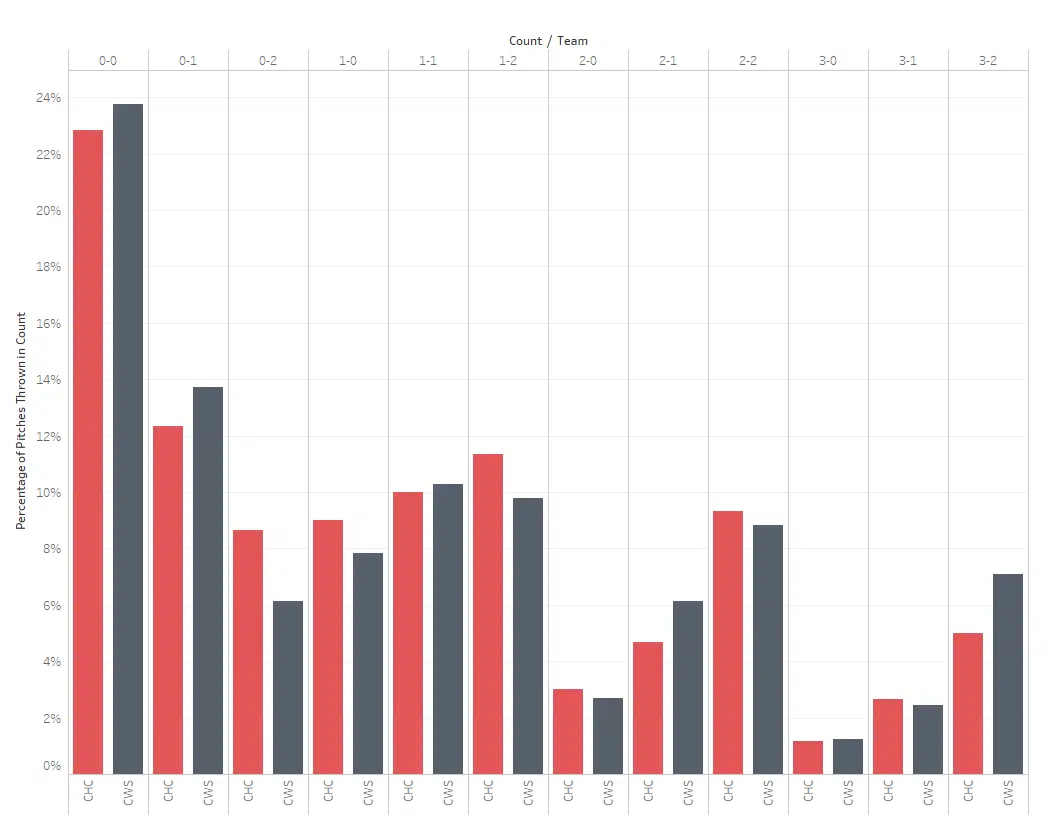
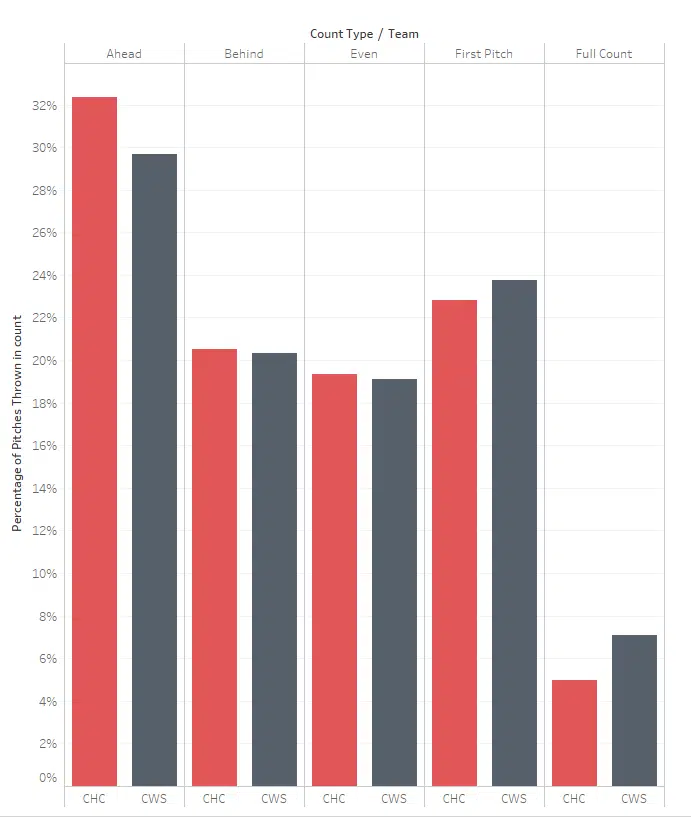
From this breakdown, we can see a few things:
- Kimbrel threw first pitch strikes more often (more pitches thrown on 0-1) with the White Sox, yet because of his failures to get the count to 0-2, spent a bit less time pitching from ahead in the count with the White Sox.
- Kimbrel spent a lot more time in full count situations with the White Sox – meaning he found himself working long at-bats more with the White Sox.
These two things signal a lack of accuracy. Were there any changes in pitch mix that might’ve been part of the decreased accuracy?
How Often Craig Kimbrel Threw Each Pitch in Each Count Before/After Trade
Note: Blue is Fastball, Red is Knuckle Curve
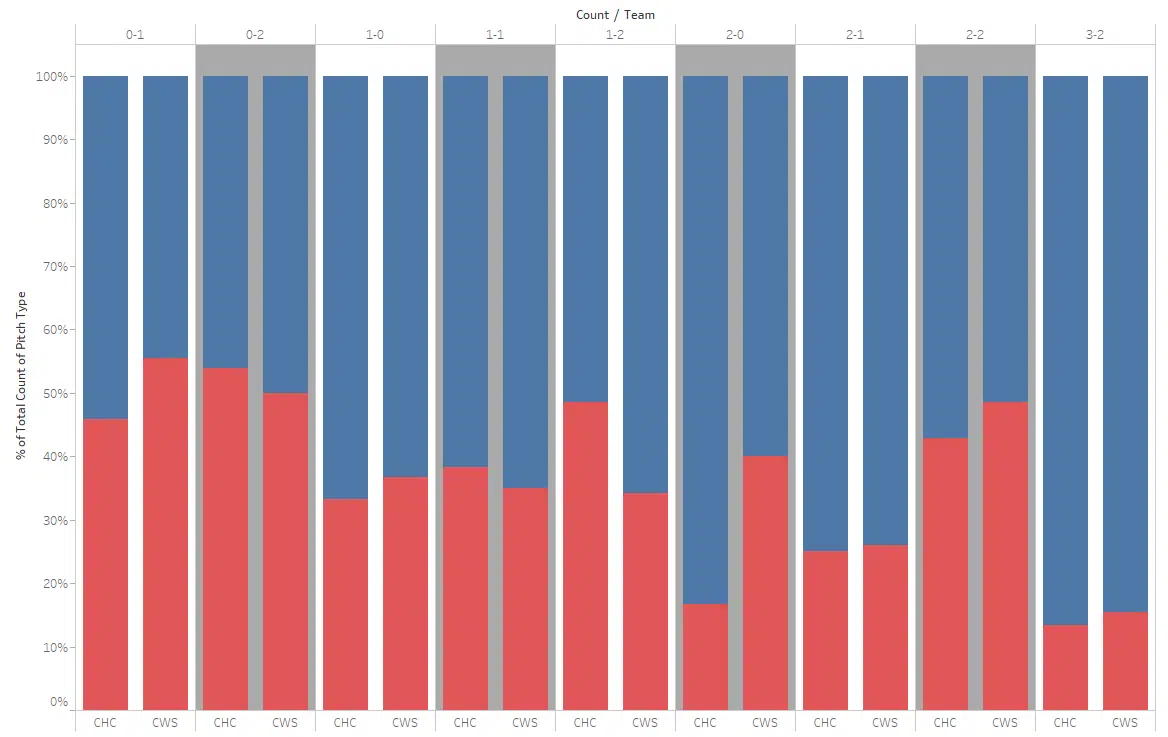
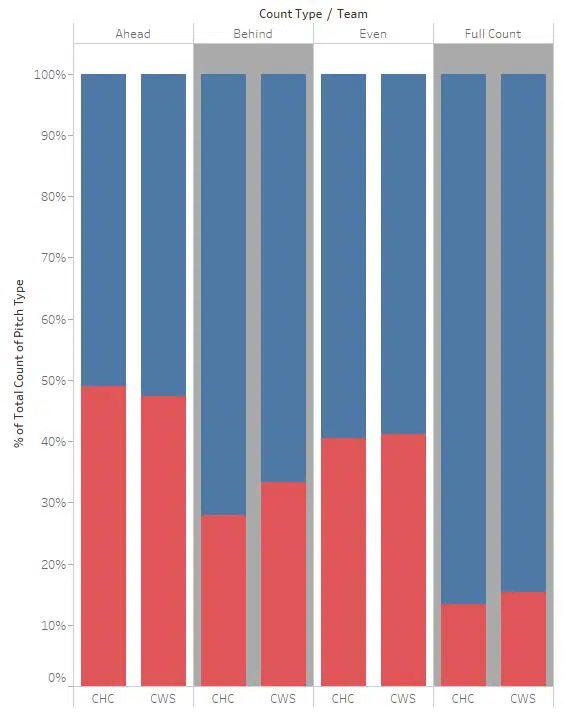
This is a confusing graphic on the surface, but overall, we can see that relatively speaking, Kimbrel’s pitch mix didn’t really change from the Cubs to the White Sox. The two situations where we see the largest difference in pitch mix are:
- On 1-2 (49% Knuckle Curve with Cubs, compared to 35% with the White Sox)
- On 2-0 (17% Knuckle Curve with Cubs, compared to 40% with the White Sox)
But, as we see below, the differences here were immaterial changes in results. Kimbrel didn’t see a higher percentage of 2-2 counts as a result of the change in pitch mix on 1-2 (meaning, he didn’t throw more balls on 1-2), and the results from the Cubs to the Sox didn’t change drastically on 1-2 counts:
- With Cubs: .059 AVG / .059 SLG / .052 wOBA
- With Sox: .071 BA / .071 SLG / .107 wOBA
In addition, even if there was an increased risk, there is nothing in the data to suggest that Kimbrel struggled drastically if the count moved from 1-2 to 2-2 while with the White Sox, as evidenced by the below table:
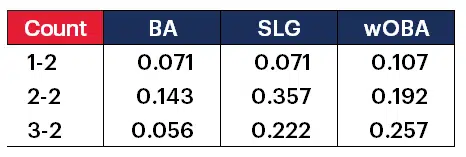
To summarize this section: the difference between Wilson Contreras and Yasmani Grandal was not a substantial one in terms of game-calling. There were some clear differences in pitch mix on a 1-2 or 2-0 count, but based on these observations, there is nothing to suggest that the change in team alone was a significant part of Kimbrel’s struggles.
Changes in Velocity
So, where next? Let’s look at Kimbrel himself. A good place to start to figure out what might’ve changed for a pitcher is with his “stuff” in general. Were there any changes to Kimbrel’s two pitches – Fastball and Knuckle Curve – once he came over to the South Side?
At first glance, we see one major change when looking at his velocity and spin rate by month:
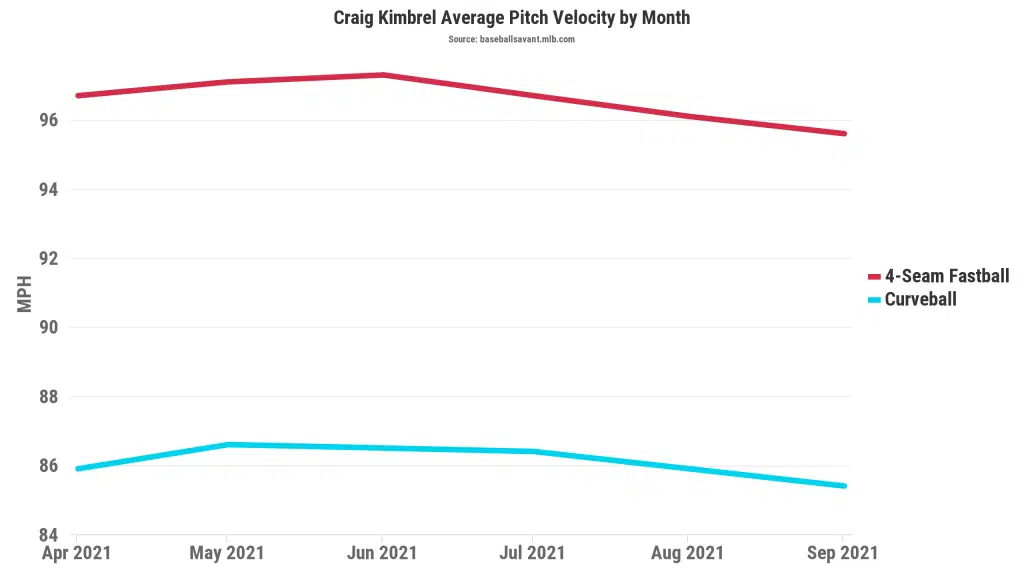
Average Pitch Velocity 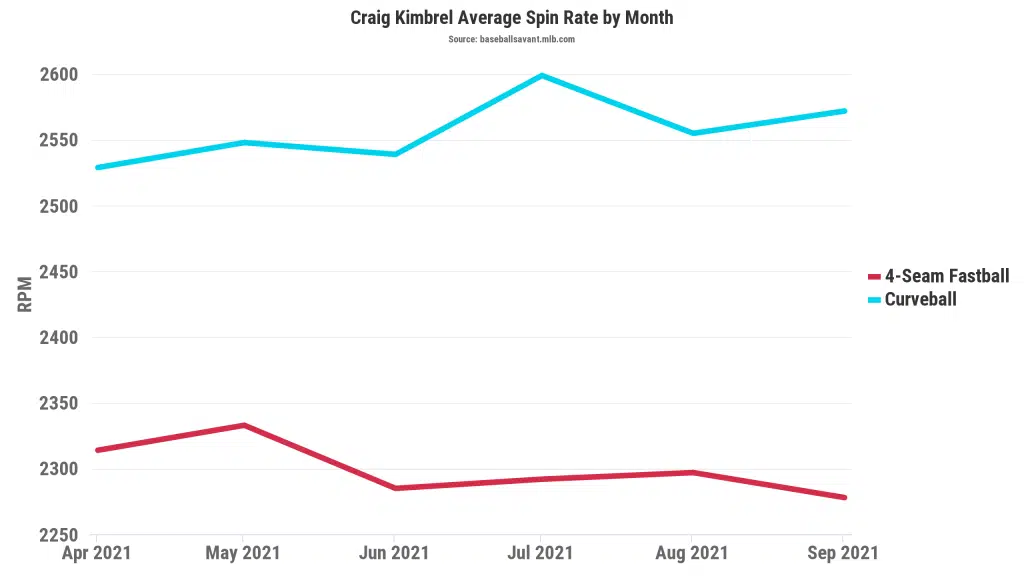
Average Spin Rate
Kimbrel’s average fastball velocity dropped all the way from 97.3 mph in June to 95.6 mph by September. That’s, uh, not great. However, at the same time, his spin rate did not see any material decrease post-“sticky stuff” ban. There’s a definite drop from its peak month in May, but a drop of 50 RPMs on average does not signify a large enough decrease to attribute it to any sort of foreign substance. In fact, for his curveball, the average spin rate increased after the ban.
Where did this drop in velocity come from? Kimbrel’s recent history in terms of innings pitched gives us the likely answer here:
- 2018 IP: 62.1
- 2019 IP: 20.2
- 2020 IP: 15.1
- 2021 IP w/CHC: 36.2
- 2021 IP w/CWS: 23.0
Simply put, in 2021, Kimbrel threw as many innings with the Cubs alone in 2021 as he did in 2019 and 2020 combined. That raises obvious questions about how prepared Kimbrel was to be able to handle that increase in workload, given two seasons with such a stark lack of innings.
Remember, before the Cubs signed Kimbrel in 2019, he spent most of the season as a free agent due to the draft pick compensation that was attached to him (Dallas Keuchel experienced the same thing in the same offseason). 2020 was already a shortened season, which did no one any favors. That brings us to 2021 – once the innings started to pile up, it appears the 33-year-old’s body wasn’t able to handle it.
What was the true effect of this drop in velocity for Kimbrel? Well, you can probably guess the results:

Craig Kimbrel’s two lowest velocity months occurred on the South Side. They were also his worst fastball months by wOBA. That shouldn’t shock you – while Kimbrel clearly made some adjustments from August to September (discussed in the next section), the loss in velocity was a clear problem.
Taking a look deeper into Swing and Miss rates reveals why velocity loss is such a problem for Kimbrel:
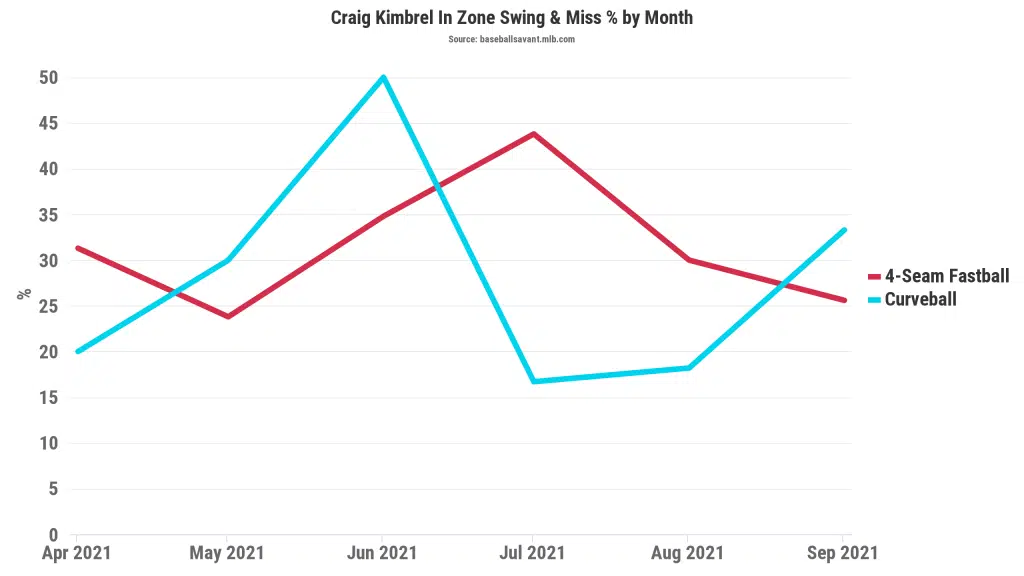
In Zone Swing and Miss 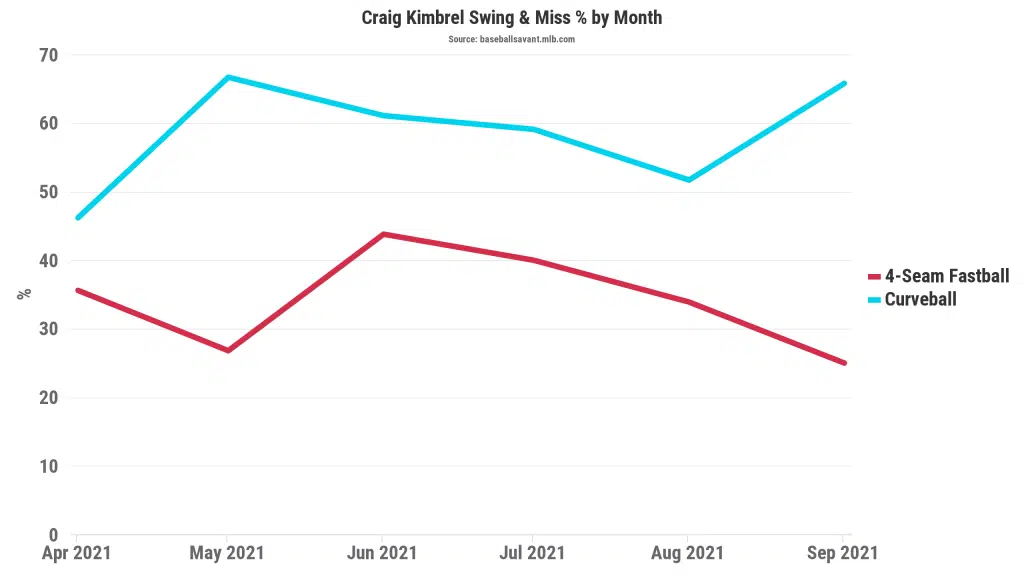
All Swing and Miss
Once Kimbrel came over to the White Sox, his fastball really stopped being an effective pitch. The strikeout rate on his fastball fell all the way from 47.4% in July to 25.8% and 30.8% in August and September, respectively. He appeared to regain some of his pre-White Sox swing and miss on his curveball late in the season, which is part of the reason he posted a 3.38 ERA and 40% strikeout rate in September/October 2021. However, that same swing and miss never returned to his fastball. Those “improved” September results (compared to August) shown above were likely the result of improvements to his Knuckle Curve, not to his Fastball.
This is an example of why the White Sox are being so cautious with Michael Kopech heading into 2022 – innings and innings load matter. Though, this likely wasn’t a problem the White Sox were anticipating from a 33-year-old potential Hall of Fame closer. That being said, he’s still a human, and humans get tired.
At this point, we’re working from the assumption that fatigue played a huge part in Kimbrel’s decline once coming to the South Side. What were the long-term effects of his fatigues throughout the season?
Loss of Consistent Mechanics
Something happened to Craig Kimbrel that turned his Heat Maps from looking like this:
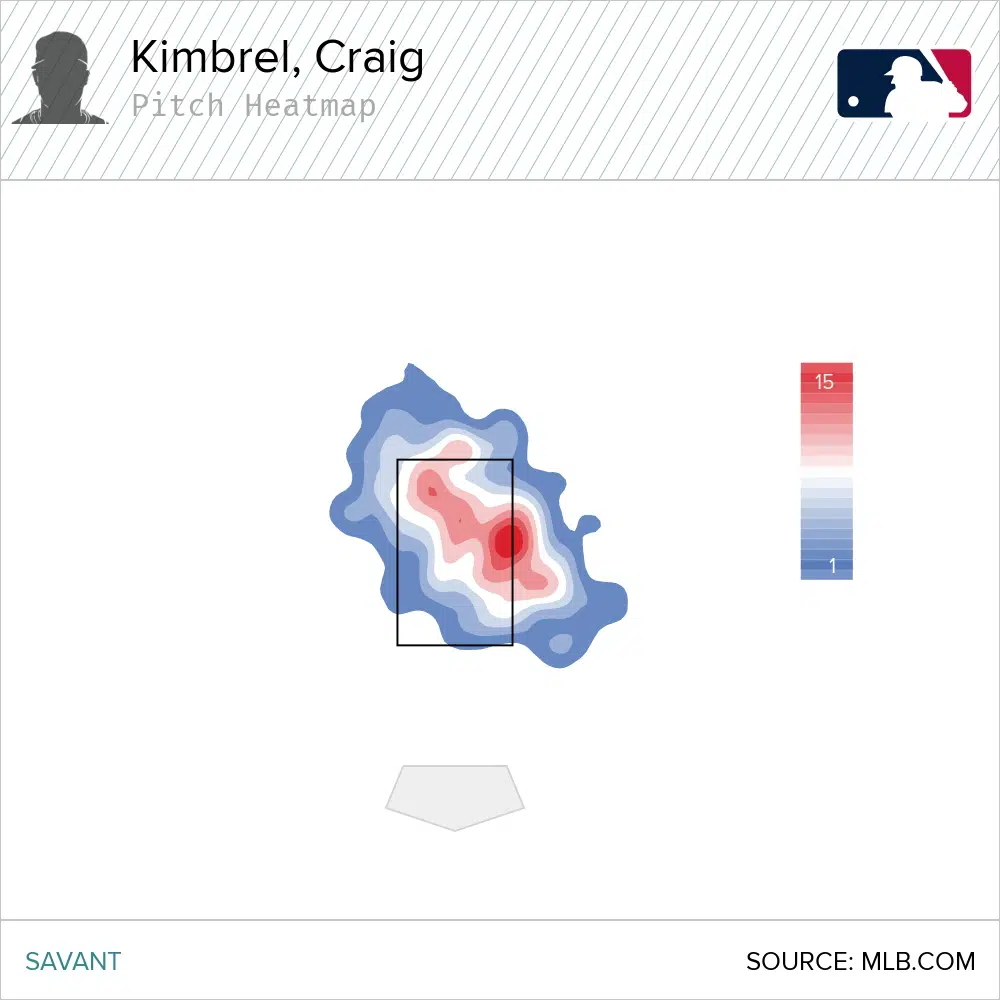
Fastball w/CHC 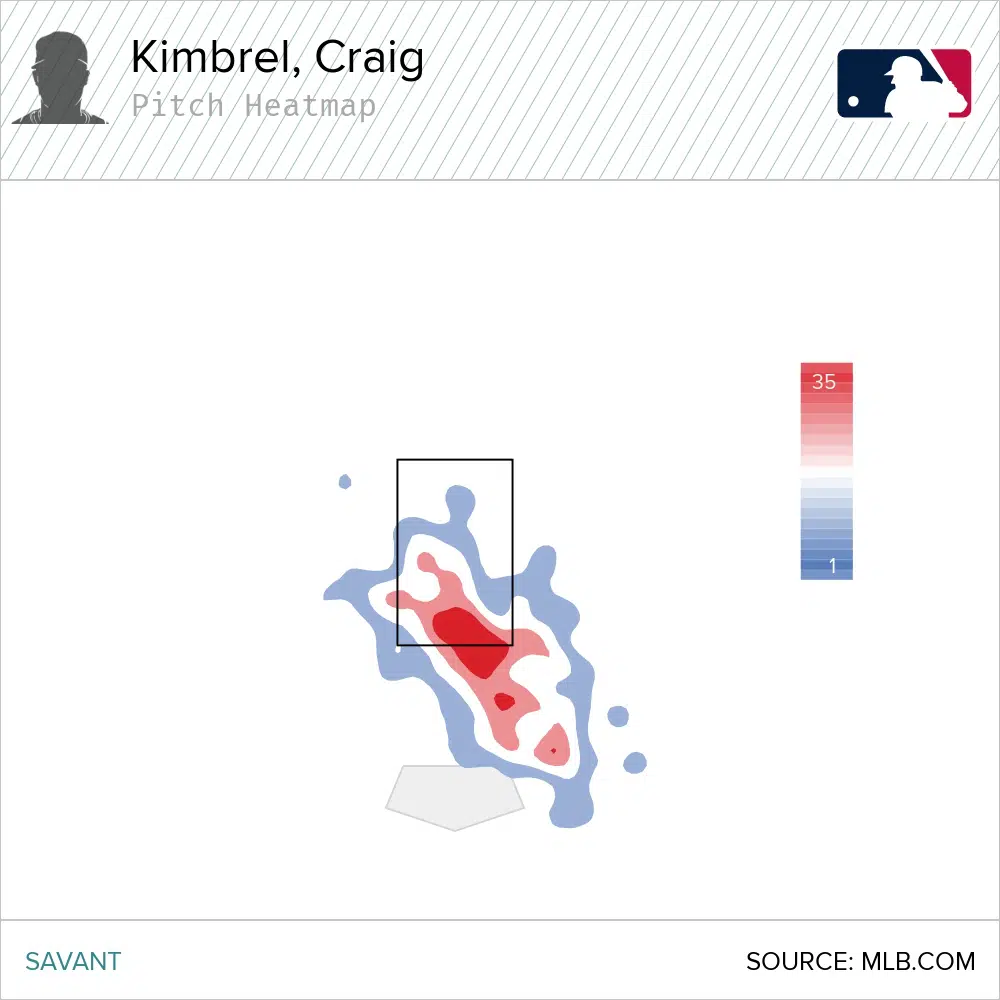
Curveball w/CHC
… to looking like this:
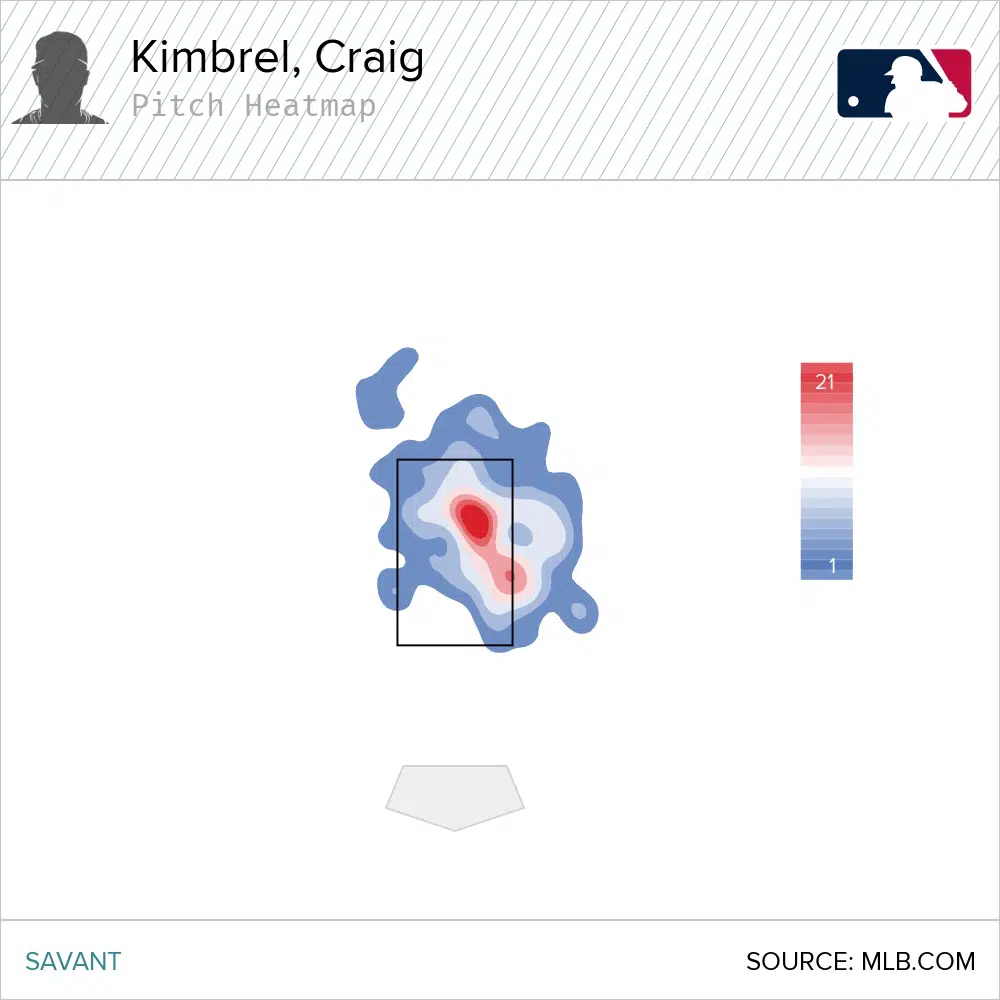
Fastball w/CHW 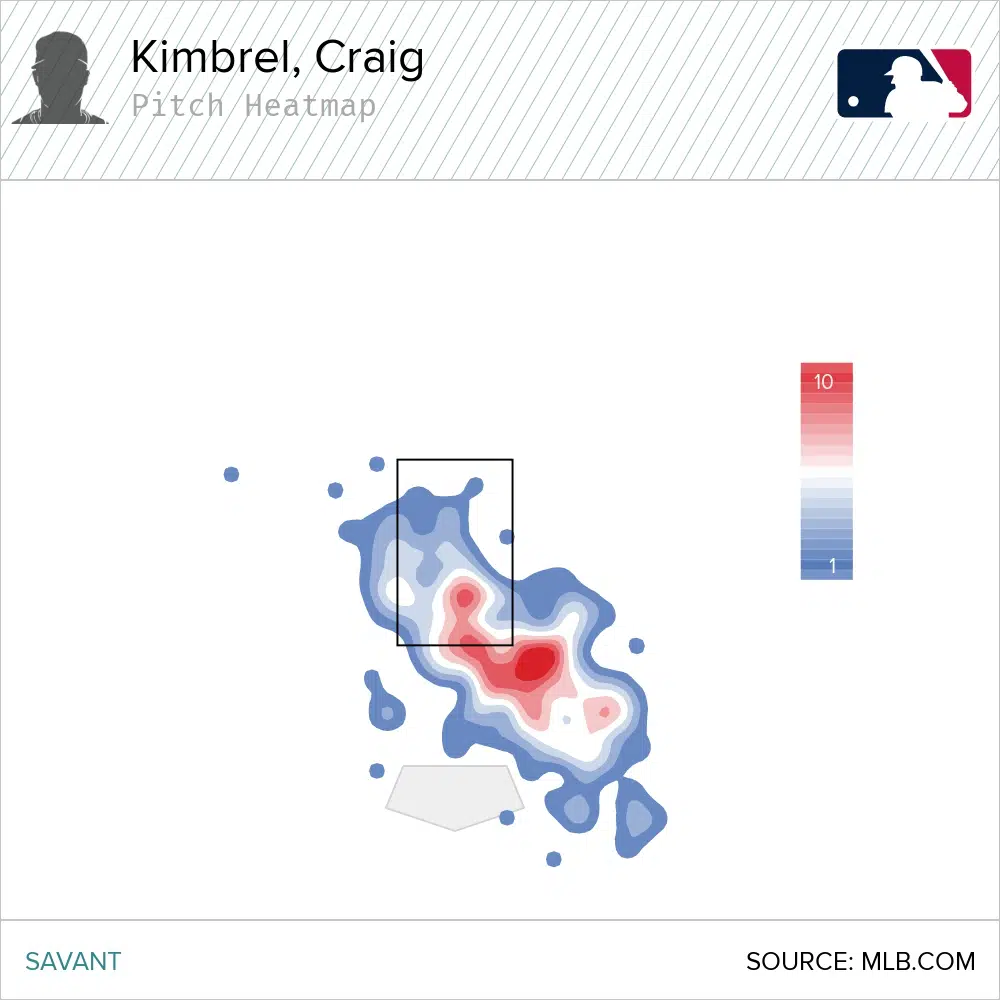
Curveball w/CHW
Kimbrel’s pinpoint control from the first half of the season absolutely disappeared on him. His fastball went from dotting the outside corner to a slower meatball down the middle of the plate.
We’ve already diagnosed likely fatigue as an issue. Did this fatigue impact his mechanics?
To get a sense of that, let’s look at the vertical release point of each of Kimbrel’s pitches by month:
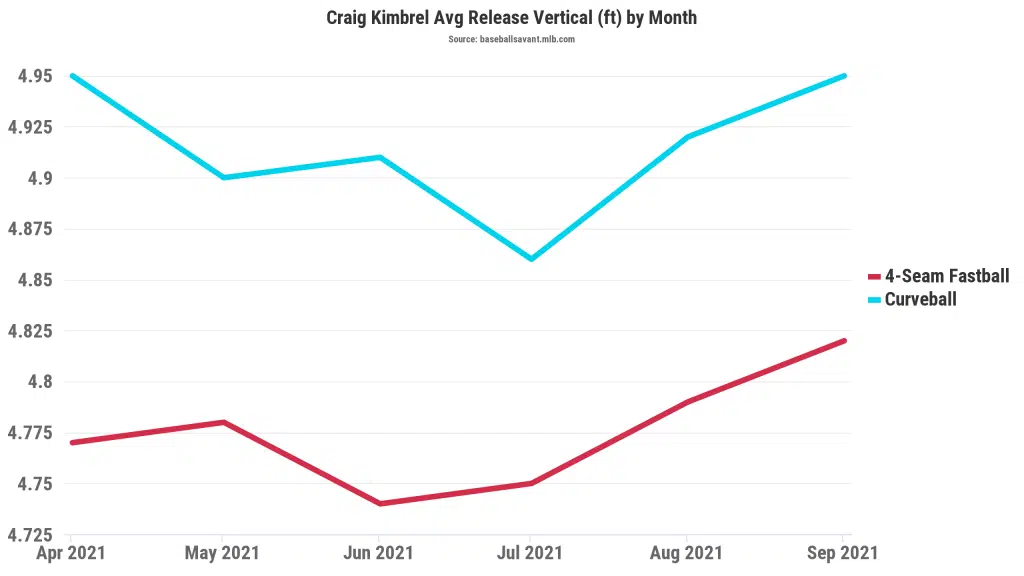
It appears that Kimbrel struggled with some inconsistency in his mechanics. Throughout the season, his release point clearly rose, which is an interesting observation.
This is a simple example, but it’s relevant here. For you Little League coaches out there: when do you know your pitcher is getting tired? When he starts throwing higher out of the zone. Why? Because his mechanics are breaking down and he’s not finishing and driving down the mound. It appears something similar was happening to Kimbrel.
Granted, these are slight changes to Kimbrel’s release point we are talking about – the axes don’t do them justice (and you can tell if you look at BaseballSavant’s scale). But even the smallest changes make a drastic impact.
Don’t believe me? Let’s take a look at some videos. Here’s an overlay of Kimbrel with both the Cubs and White Sox pitching at Detroit. One of these pitches dots the inside corner. The other is in the left-handed batter’s box.
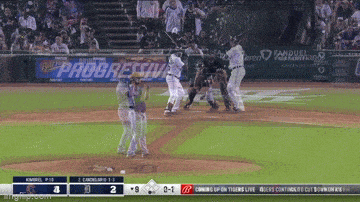
Because I’m not a video editor – and because the cameras are (aggravatingly) at slightly different angles, here are each of the videos alone.
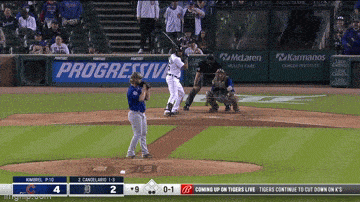
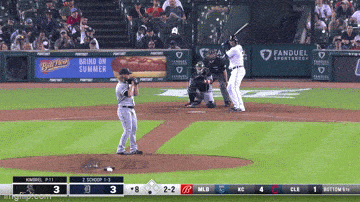
Finally, here is Kimbrel in the frame right before he releases the ball:
See anything? I can point out a few things, all of which I feel stem from overcompensation due to fatigue/lack of velocity:
- He’s using his arm to create a lot more of the whip action in his mechanics, causing his front side to fly open. Notice how much more his body drives down the mound with the Cubs – he’s standing much straighter with the Sox.
- This can also be seen in how he finishes. Notice how Kimbrel’s back leg whips around a lot more with the Cubs. With the White Sox, because he’s all arm, his back leg just kind of comes through without the same amount of power. In short, he’s not using his legs.
- In the picture below, you can also see the INCREDIBLY slight differences in his release point that are making a large difference – the camera angles might even exaggerate the difference more than there is. Truthfully, I think it’s also pretty easy to see these differences in the separate images above.
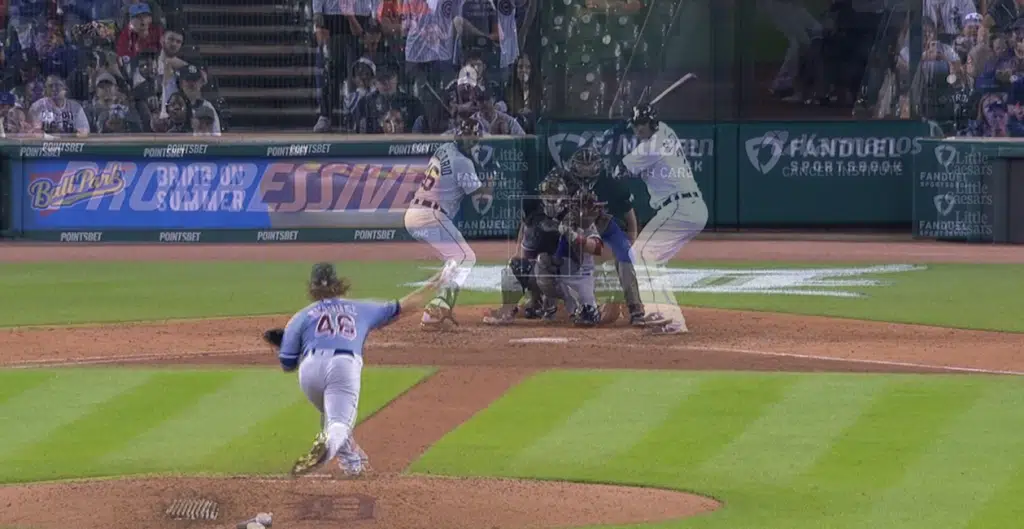
Again, the differences are SO slight – and even harder to align with the camera angles. But, it’s there – Kimbrel is standing taller with a slight increase in vertical release point with the White Sox (notice how you can see both his right arms – though slightly – in the above picture). This is because he wasn’t driving down the mound, causing him to overcompensate with more arm action rather than utilizing his lower half fully. In simpler terms: Craig Kimbrel lost his consistent mechanics from the first half of the season.
This is why Kimbrel yanked so many fastballs glove-side throughout the end of the season – when you’re using your arms, rather than your legs, your mechanics are going to naturally fall out of sync as your upper body rotates before your lower body does. When Dylan Cease struggles with command, the exact same thing happens.
The easy culprit here: the fatigue we talked about earlier. His body was simply more tired and wasn’t generating power down the mound. It’s a chicken/egg argument between the loss in velocity and the loss in mechanics, but both go hand-in-hand because they have the same origin: fatigue. If anything, the inconsistency mechanics only exacerbated the velocity problems.
The “Narrative”
Thus far, we have our story. Kimbrel, off of two years of decreased usage due to variables outside of his control, started getting a bit tired as the season went on. The fatigue affected both his pitches in the form of decreased velocity and, due to increasingly inconsistent mechanics, location. Hitters could square up his fastball more easily when it found the plate, and the curveball was inconsistent at best.
However, for many, there is still another layer to this – and I feel it’s worth addressing here still.
In other words, many people wanted to chalk up Kimbrel’s struggles to a change in role – from the 9th inning closer of the Cubs to the 8th inning setup man of the White Sox.
If you’ve read my work before, you know where I stand on “closers” – your job is to protect the lead the team has given you. It shouldn’t matter if it’s the 7th, 8th, or 9th inning. When the team calls your number to protect a lead or keep a deficit close, your job is to pitch your best in that situation. The White Sox already have a player who can do that in Liam Hendriks. Craig Kimbrel is a potential Hall of Fame relief pitcher. His stuff is good enough that he should be able to get outs whenever his number is called. So, I don’t really buy into this argument as much as most do, especially in modern baseball where there is an increased need to pitch whenever your number is called, not just in a specific situation that may or may not ever come. If your closer is your best reliever, why would you only save him for a save situation when you may not even get to a save situation because you blew the lead in the eighth? Wouldn’t you rather lose with your best guys on the field?
However, as I’ve been told before – and, as I understand from when I played baseball (yup, I’m not just a numbers nerd!) – the ninth inning presents a different mentality for some players. Perhaps Kimbrel is this type of player – especially when considering all he really knows in the major leagues is the closer role.
I’m willing to meet the reader halfway on this topic. I’m willing to admit that there is a likelihood that Craig Kimbrel struggled to adjust to a role outside of being a closer because of his work as a closer for 10+ seasons. I don’t think it’s a big impact – nor do I think it should be. But I’m willing to concede that this game isn’t played on computers.
However, I’m hoping after reading this, that you’re willing to admit that based on the data, this isn’t the main reason that Kimbrel struggled after making the transition to the South Side. There are too many changes in mechanics and velocity to say that the biggest or only reason Kimbrel struggled with the White Sox is that Tony La Russa didn’t use him in the ninth inning.
If we can all admit that, then I can admit there is a factor – no matter how big/small – that I can’t quantify. Deal?
The Verdict
As we come towards the end here, I have a renewed sense of optimism that:
- The White Sox can use some of their data to craft a convincing story about why Kimbrel struggled. As a result, they should still be able to get something of value in return for Kimbrel.
- If the White Sox end up saddled with Kimbrel heading into 2022, I don’t think the team would be stuck with a James Shields-esque pitcher.
Here’s why. If fatigue and inconsistent mechanics are to blame, there is work that can be done there. Kimbrel was hitting 99 last year – he can still do it, and assuming a solid offseason routine, he should be able to return to a quality form – Kimbrel isn’t as bad as he was down the stretch. I think the White Sox can make a pretty convincing case between a dip in velocity due to odd 2019-2020 seasons, and a likely preference for a closer role and the routine that comes with it, that Kimbrel still has plenty left in the tank.
The flip side is obvious: Kimbrel will be 34 next year, so he’s not exactly a spring chicken. Are teams going to be willing to take a chance that the above is true? I’m not sure – based on my research, I still think they should be. But, if teams aren’t willing to take on Kimbrel, I can absolutely still see Kimbrel as a worthy investment in the creation of a true “super bullpen” – unless the White Sox know something we don’t about the reason behind Kimbrel’s drop in velocity. Point #2 above does open the monetary/budgetary argument that likely shuts other doors – but that’s a topic for another article.
As we head into a new year full of renewed optimism, I find myself viewing Craig Kimbrel through this same optimistic lens. For monetary reasons, my hope is that he is not on the South Side in 2022. But, contrary to many, I don’t believe he’s a lost cause – I think he’s a case of unintended consequences that resulted in a long 2021 season after two consecutive short ones.
Only time will tell on this Sweet Child O’ Ours. Let’s hope the song sounds as sweet in 2022 as we thought it would in 2021.
Featured Image: Chicago White Sox (@whitesox) / Twitter

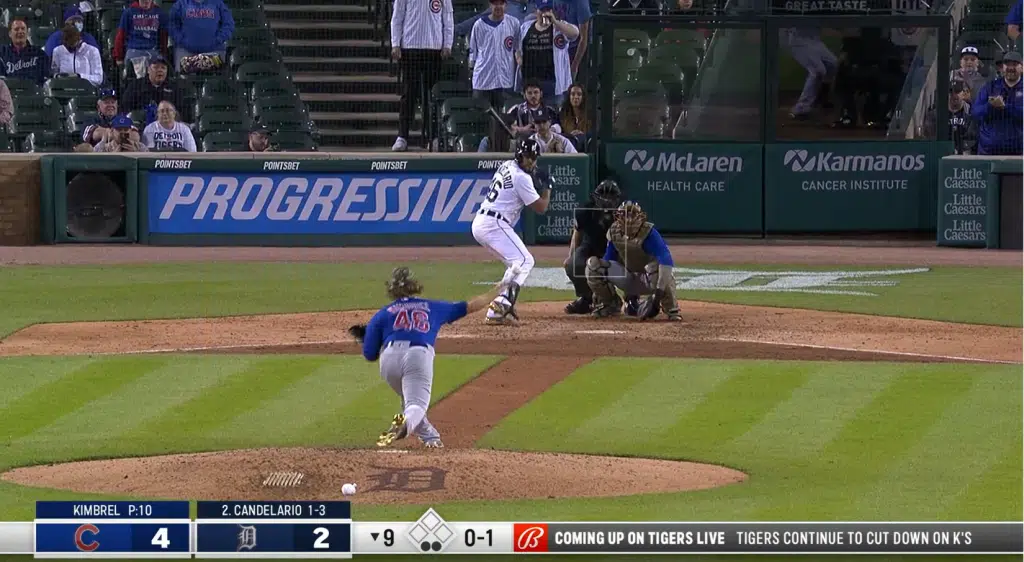
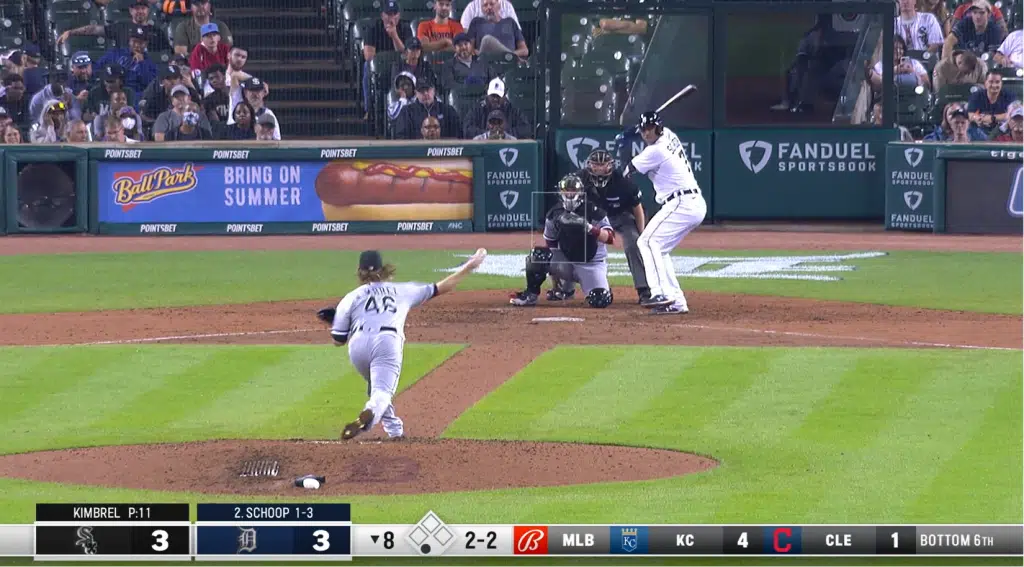
[…] regular-season innings over the 2019-20 seasons, before jumping back up to 59 2/3 IP in 2021. As Jordan Lazowski of the Sox On 35th blog observed, Kimbrel’s fastball velocity declined by 1.7 mph from June to September, […]
Really good read. I’m encouraged. Losing Madrigal last year sucked, I think he’s the exact hitter the Sox could use in the future to balance all the power we have and to think we lost him for a dud… a CUB dud… it made me feel like the Front Office was in over there head. It gave me “Here we go again” vibes. Plus seeing all the movement in the AL this off season made me feel likemaybe our ceiling isn’t high enough. But if this is the reason he wasn’t strong after the trade then I kinda hope we keep him. The late relief would be everything we hoped for last summer. Down right ELITE with Graveman. We do need another bat but I’m hoping a healthy Eloy and Luis plus progression from Vaughn will make up some of the gap, with an additional acquisition putting us over the top. Go Sox ?
Thanks so much for reading! Go Sox